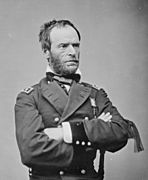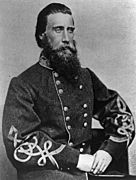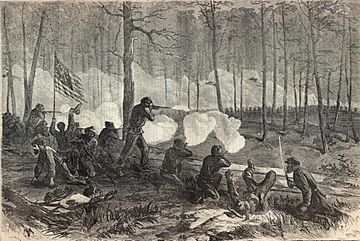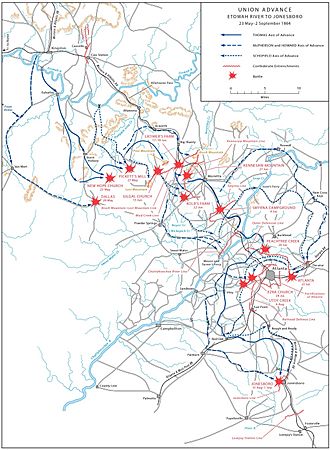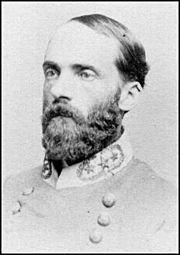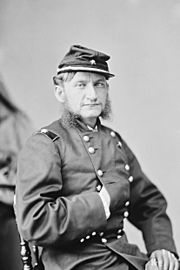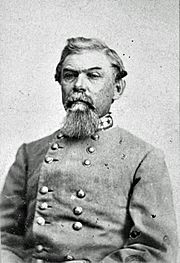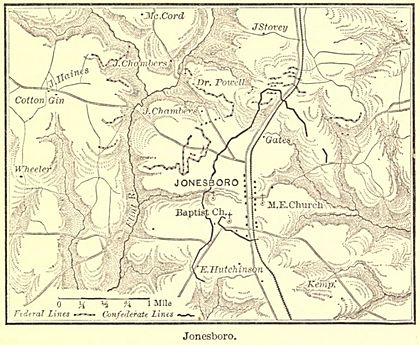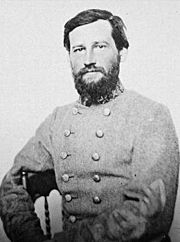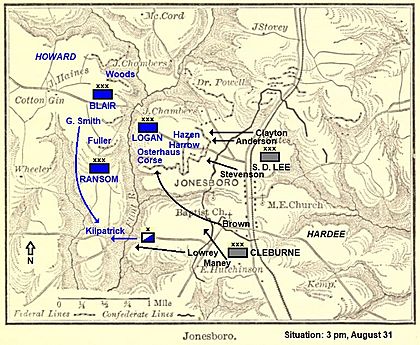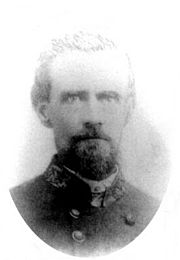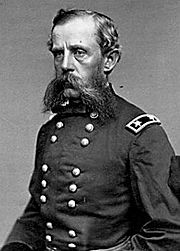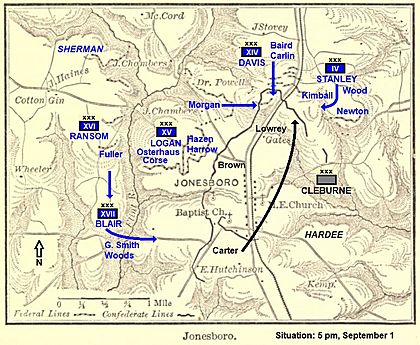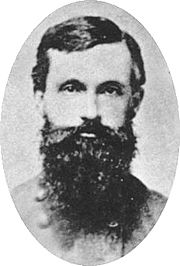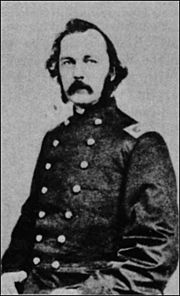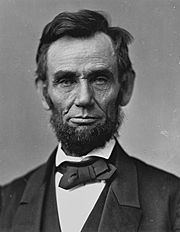Battle of Jonesborough facts for kids
Quick facts for kids Battle of Jonesborough |
|||||||
|---|---|---|---|---|---|---|---|
| Part of the American Civil War | |||||||
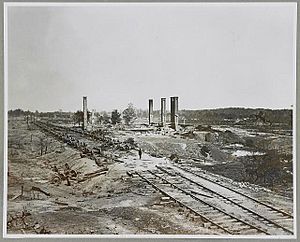 Ruins of rolling mill and railroad cars destroyed by Confederates on evacuation of Atlanta, Georgia |
|||||||
|
|||||||
| Belligerents | |||||||
| Commanders and leaders | |||||||
|
|||||||
| Units involved | |||||||
| Army of the Tennessee Army of the Cumberland |
Army of Tennessee | ||||||
| Strength | |||||||
| Campaign: 85,000 Aug. 31: 14,170–19,500 Sept. 1: 20,460 |
Campaign: 55,000 Aug. 31: 20,000–23,811 Sept. 1: 12,000–12,661 |
||||||
| Casualties and losses | |||||||
| Aug. 31: 172–179 Sept. 1: 1,272–1,274 |
Aug. 31: 1,700–2,200 Sept. 1: 1,400, 8 guns |
||||||
The Battle of Jonesborough happened from August 31 to September 1, 1864. It was a key battle during the Atlanta Campaign of the American Civil War. Union Army forces, led by General William Tecumseh Sherman, fought against Confederate troops under General William J. Hardee.
On the first day, Confederate soldiers attacked the Union forces but were pushed back with many losses. That night, General John Bell Hood, the main Confederate commander, ordered half of Hardee's troops to return to Atlanta. On the second day, five Union army groups attacked Jonesborough. For the first time in the Atlanta Campaign, a major Union attack broke through the Confederate defenses. The Union soldiers captured 900 prisoners. However, the Confederates managed to stop the breakthrough and create new defenses. Despite being greatly outnumbered, Hardee's troops managed to escape south that evening without being noticed.
Sherman had tried before to make Hood leave Atlanta. This time, he decided to sweep south with most of his infantry (foot soldier) groups. His main goal was to cut off the Macon and Western Railroad. This was the last working railroad line into Atlanta. Three Union groups got close enough to the railroad at Jonesborough to fire cannons at it. Hood reacted by sending two of his three infantry groups to push them away. While the fighting at Jonesborough was happening, two more Union groups cut the railroad on August 31. When Hood found out Atlanta's railroad lifeline was cut, he left the city on the evening of September 1. Union troops took over Atlanta the next day, ending the Atlanta Campaign. Even though Hood's army was not completely destroyed, the fall of Atlanta had a huge impact on the war, both politically and militarily.
Contents
Background to the Battle
The Armies Involved
In the Atlanta Campaign, General William T. Sherman led the Union's Military Division of the Mississippi. This included parts of three Union armies. At the start, George H. Thomas led the Army of the Cumberland. James B. McPherson led the Army of the Tennessee, and John Schofield commanded the Army of the Ohio.
After McPherson died in the Battle of Atlanta on July 22, there were some big changes. Sherman chose Oliver Otis Howard to take McPherson's place. Other generals also took on new roles.
Sherman's forces had about 85,000 soldiers at their peak. By September 1, they had about 81,758 soldiers.
The Confederate Army of Tennessee was led by General Joseph E. Johnston at the start of the campaign. It had three main infantry groups, Georgia militia (citizen soldiers), and cavalry. Johnston was replaced by General Hood on July 17.
Hood's army was estimated to have about 55,000 soldiers in August.
How the Campaign Unfolded
The Atlanta Campaign started in May 1864. Sherman's 100,000 Union soldiers moved against Johnston's 62,000 Confederates. Both sides received more soldiers during the campaign. Atlanta was a very important Confederate city. It was a major railroad center, a place where goods were made, and a supply point. Because of this, Sherman made it his main target.
There were several big battles as Johnston's army was pushed back towards Atlanta. These included Battle of Rocky Face Ridge, Battle of Resaca, Battle of New Hope Church, and Battle of Kennesaw Mountain. Johnston was replaced by Hood after Sherman's forces went around the Confederate army's defenses near the Chattahoochee River. Hood attacked Sherman's armies at the Battle of Peachtree Creek and the Battle of Atlanta. Both of Hood's attacks failed, and the Confederates lost many soldiers.
Sherman's troops damaged the Georgia Railroad east of Atlanta. Sherman then moved the Army of the Tennessee to the west side of Atlanta. He wanted this army to cut the Macon and Western Railroad, which went south from Atlanta. On July 28, Howard's army was stopped at the Battle of Ezra Church. However, the Union won this battle, with far fewer losses than the Confederates.
Union cavalry (soldiers on horseback) tried to cut the Macon railroad, but these attempts failed. General George Stoneman was even captured with 700 of his men. Sherman then tried to bombard Atlanta with cannons, but this also failed.
Hood ordered Confederate cavalry under General Joseph Wheeler to destroy the railroads supplying Sherman's army. Wheeler caused some minor damage but was not a major threat. Sherman then sent Union cavalry under General Hugh Judson Kilpatrick to break the Macon railroad. Kilpatrick's raid caused some damage, but the Confederates quickly repaired the tracks. So, this raid was another failure for the Union.
The Jonesborough Plan
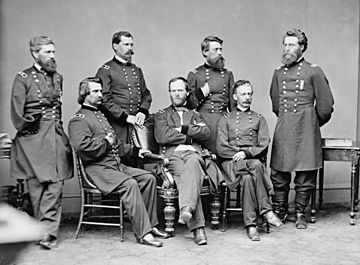
Sherman knew the Macon and Western Railroad was still working on August 23. He decided to move most of his army south to cut this last railroad line. On August 25, the Union army began to move out of its positions. Most of Sherman's forces marched south, leaving only a small part to guard the railroad bridge. Hood noticed the movement but didn't try to stop it. By August 28, Sherman's main forces were on the Atlanta and West Point Railroad west of Atlanta. Sherman's troops spent August 29 destroying this railroad.
Some believed Hood thought Sherman was retreating. However, others argue that Hood knew Sherman was planning a big attack to the south. Hood's problem was that he didn't know exactly where Sherman was going. He didn't realize Sherman's forces would reach Jonesborough "so soon, so close, and so strong."
On August 30, Howard's Army of the Tennessee began marching south towards Jonesborough. They faced some resistance from Confederate cavalry. Howard's leading troops reached the Flint River and captured a bridge before the Confederates could burn it. Logan's XV Corps crossed the river and dug in west of Jonesborough by nightfall. Howard decided not to attack yet, not knowing there were only 2,500 Confederates in Jonesborough.
By 6 pm on August 30, Hood realized Jonesborough was in serious danger. He ordered Hardee's corps, followed by Lee's corps, to march to Jonesborough during the night. Hood told Hardee to take command of both groups and attack the Union forces in the morning. He wanted them to push the Union soldiers into the Flint River. If Hardee's attack failed, Lee's corps was to return to Atlanta to cover the army's retreat. Hood also ordered military supplies to be prepared for evacuation from Atlanta by train.
Opposing forces
Union
Confederate
The Battle of Jonesborough
August 31: The First Attack
On the morning of August 31, Howard received orders from Sherman to take and fortify a point on the railroad. Howard replied that the Confederates were sending many troops and planned to attack him. Hardee found he couldn't attack the Union forces in the morning as planned. His corps didn't arrive until dawn, and Lee's corps wasn't expected until noon. Hardee asked Hood to come and take command, but Hood repeated his order to attack. Meanwhile, Howard's troops were busy making their defenses stronger.
Howard's XV Corps was set up with divisions on the right and left, and one in reserve. Other Union corps were positioned to support each other. Howard had about 12,000 troops in the front line and 7,500 in reserve.
By 1:30 pm, S. D. Lee's corps finally reached Jonesborough. His soldiers were very tired. Hardee and Lee had about 20,000 soldiers ready to fight. Hardee arranged his forces with his own corps on the left and Lee's on the right.
Hardee planned a big attack, starting from the left and moving right. He told his generals that the troops must attack with bayonets (knives attached to rifles). However, some soldiers seemed tired and not eager to charge.
August 31: The Attack Begins
Confederate cannons opened fire at 3 pm. Lee's corps attacked too early, thinking the skirmish (small fight) fire was the signal. Lee's first line of troops quickly reached the Union picket lines (outposts). But they were stopped by heavy rifle and cannon fire. Many Confederate soldiers ran away. The second line attacked and met the same fate. It was a terrible loss for the Confederates. Even though their generals urged them on, the soldiers lay down and refused to charge. Once the attack stopped, Union soldiers fired "with terrible accuracy."
Meanwhile, another Confederate division moved northwest. It was hit by fire from Kilpatrick's dismounted cavalry, who were hidden and had powerful repeating rifles. The cavalry's fire was so strong that the Confederates changed their attack. They charged west against the Union cavalry instead of the main Union line. Kilpatrick's men fought off two attacks but were forced to retreat. Instead of going back to their original target, the Confederates kept pushing the cavalry across the Flint River. They were finally stopped by another Union division. Howard said this was perfect, as it drew an entire Confederate division away from the main battle.
Other Confederate divisions also faced heavy fire and could not advance. Hardee wanted to attack again, but Lee said his troops were too tired. Howard reported only 172 Union casualties (killed, wounded, or missing). Confederates lost about 2,200 soldiers.
At 3:45 pm, Howard told Sherman that the Confederates had attacked and were "handsomely repulsed" (pushed back well). About an hour later, Sherman received even bigger news. Another Union corps had reached the Macon and Western Railroad, cutting it off. Sherman was thrilled; he had finally cut Atlanta's railroad lifeline.
Hood received reports that the railroad was blocked. He feared Sherman would attack Atlanta from the south. At 6 pm, he ordered Lee's corps to return to Atlanta, starting at 2 am. Hardee's corps was ordered to "protect Macon and communications in rear." Hood later called the fighting on August 31 a "disgraceful effort" for the Confederates.
September 1: The Second Day
Around midnight, Hood finally learned that Hardee's attack had failed. He realized this meant Atlanta had to be abandoned. He issued the orders to leave the city. When Lee's corps left Jonesborough, Hardee's remaining 12,000 troops had to defend a 2-mile (3.2 km) front. They were spread out very thinly. They tried to build defenses, but they didn't prepare abatis (a barrier of sharpened stakes).
At dawn on September 1, Union forces began destroying the railroad north of Jonesborough. Sherman planned to have more Union corps join the attack on Hardee's right flank. Hardee noticed this and reinforced his right flank. The right side of his line was bent back to defend against an attack from the north and northeast.
September 1: The Final Attack
Just after 4 pm, the Union XIV Corps began its attack. Other Union corps moved up to support them. The Union soldiers faced thick bushes and strong Confederate defenses. One Union brigade was stopped by the abatis (sharpened stakes) in front of the Confederate lines.
The Union commander, Davis, realized the Confederate right flank was bent back. He decided to attack this weak point. At 5 pm, the attack began. Union soldiers charged, threw themselves to the ground to avoid Confederate fire, and then charged again. Two regiments broke through the Confederate lines.
Other Union divisions joined the attack. They circled behind a Confederate brigade, hitting it from the west. In the chaos, the Confederate commander, Govan, and 600 of his men were captured. Eight Confederate cannons were also taken. Farther east, Union troops overwhelmed other Confederate brigades, capturing hundreds more. This was the only successful large-scale frontal attack for the Union in the Atlanta campaign.
Responding to the emergency, Confederate forces quickly moved to fill the gaps and stop the Union advance. On the east side of the railroad, a Confederate brigade rallied and pushed back a Union brigade. Union forces did not try to push their success further. Other Union corps also advanced but were slowed by thick bushes and strong Confederate defenses. It soon became too dark to do anything more.
The Union XIV Corps lost 1,272 men on September 1. These losses were perhaps unnecessary, as the Macon and Western Railroad had already been cut on August 31, making Atlanta impossible to defend. Confederates lost about 1,400 soldiers, including 900 prisoners.
On the night of September 1, Hardee's corps quietly left Jonesborough and marched away, completely unnoticed by the Union army. Some historians say this was a tactical victory for the Confederates. Hardee's defense allowed Hood to safely evacuate Atlanta. On the evening of September 1, Hood's other corps and the Georgia militia left Atlanta. Five locomotives and 81 train cars were trapped in Atlanta. The Confederates set them on fire. Since 28 cars were full of ammunition, the explosions were huge and could be heard for miles. Union troops occupied Atlanta on September 2.
Aftermath of the Battle
Sherman's troops marched south and found Hardee's 10,000 troops dug in near Lovejoy's Station on September 2. There was some minor fighting, but Hardee did not retreat. On the morning of September 3, Sherman received official news that Atlanta was in Union hands. He decided it was time to end the campaign. The Union army stayed facing Hardee until September 5, then returned to Atlanta. Sherman announced to his troops that they had completed their mission by taking Atlanta.
Sherman had several chances to destroy a large part of Hood's army, but he didn't. He focused only on his main goal: capturing Atlanta by cutting its railroad connections. Hood's army survived to fight another day, though it was weaker due to losses and soldiers leaving.
However, Sherman's capture of Atlanta was a huge victory for the Union, especially politically. At the time, the war seemed stuck. The North needed a victory before the 1864 election. The capture of Atlanta showed the people of the North that the war was being won. The Democratic Party had said the war was a failure, but the fall of Atlanta proved them wrong. Supporters of President Abraham Lincoln and the Republican Party were very happy. In the South, the fall of Atlanta caused great sadness. Lincoln went on to win the 1864 United States presidential election by a large margin.
In 1872, many fallen soldiers were dug up and reburied in the Patrick R. Cleburne Confederate Cemetery.
In Popular Culture
Famous scenes in the 1939 American film Gone with the Wind show the huge fires in Atlanta after the Confederate army left the city.
Images for kids
-
Seated Union generals are (l to r) Logan, Sherman, and Slocum. Standing are one-armed Howard, Hazen, Davis, and Joseph A. Mower. Only Mower did not serve in the Atlanta campaign.


